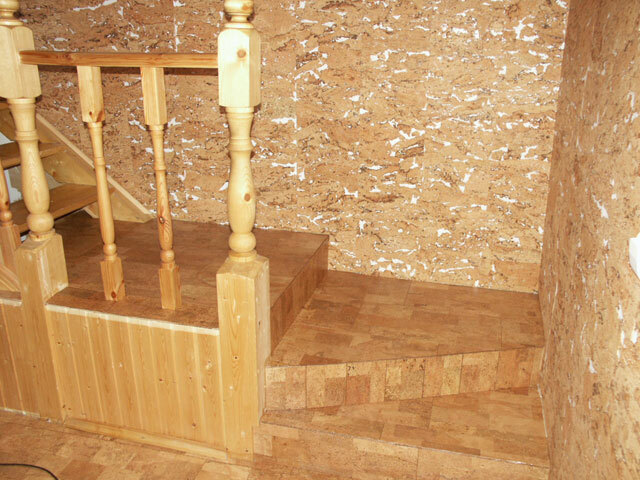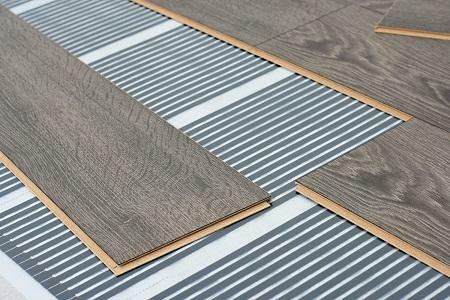 can be placed under the laminate for both electric and hot water floor. Laminate( laminated fiberboard) is a modern floor covering based on wood. This flooring is characterized by high strength, durability, relative moisture resistance( depending on the class), ease of installation and a beautiful appearance. Information on the class and the main properties of the laminate can be found on the labeling of this finishing material. Before you choose and make a warm floor under the laminate, you should purchase a laminated fiberboard 32-34 grades. What kind of floor heating with a laminated wood coating to choose, and that this should be taken into account - read further.
can be placed under the laminate for both electric and hot water floor. Laminate( laminated fiberboard) is a modern floor covering based on wood. This flooring is characterized by high strength, durability, relative moisture resistance( depending on the class), ease of installation and a beautiful appearance. Information on the class and the main properties of the laminate can be found on the labeling of this finishing material. Before you choose and make a warm floor under the laminate, you should purchase a laminated fiberboard 32-34 grades. What kind of floor heating with a laminated wood coating to choose, and that this should be taken into account - read further.
-
- Floor heating for laminate flooring: prerequisites
- Laying of floor heating for laminate flooring: what to take into account
- Electrical underfloor heating: device and characteristics
- Laminate floor heating from water heating: importantMoments
- Infra-red floor for laminate:
- features
Floor heating for laminate: necessary conditions
Floor covering withodogrevom - one of the most comfortable, convenient and aesthetic heating option. Warm floors provide physiological comfort and are more environmentally friendly than radiator heating.
There are the following floor heating types for laminated fiberboard:
- Infrared electric;
- Water;
- Cable electric.
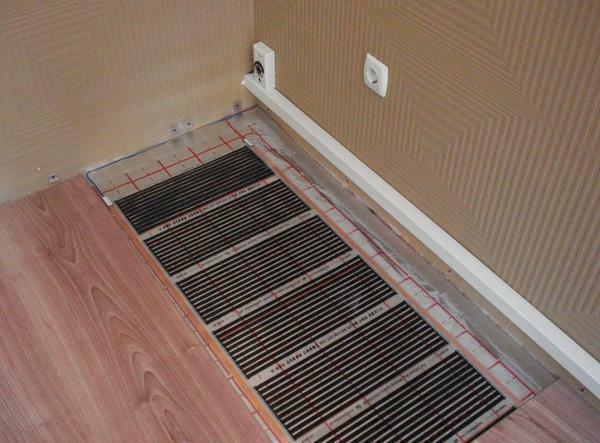 It is recommended to level the ASD50 ASD
It is recommended to level the ASD50 ASD  before laying the warm floor
before laying the warm floor
The difference in height of the base floor before laying the final coating should be no more than 3 mm / 1 m. The choice of heated floor for laminated fiberboard depends on several factors - the quality and consistency of the base base, the humidity level in the room, the required floor temperatureetc.
Laying of the warm floor under the laminate: what should be taken into account
The warm floor under the laminate can be laid in such a way as to comply with the basic requirements for installing the laminate in order not to face serious problems in the future.
Namely:
- The difference in the heights of the substrate for the laminate should not be more than 3 mm( achieved mainly by creating a concrete screed).
- It is necessary to place a vapor barrier film of a certain thickness( not less than 200 μm) on the base base.
- Stacking between vapor barrier film and substrate laminate( cork, foamed polystyrene, extruded polyethylene, etc.).
- The device is effective, easy to operate and repair the warm floor.
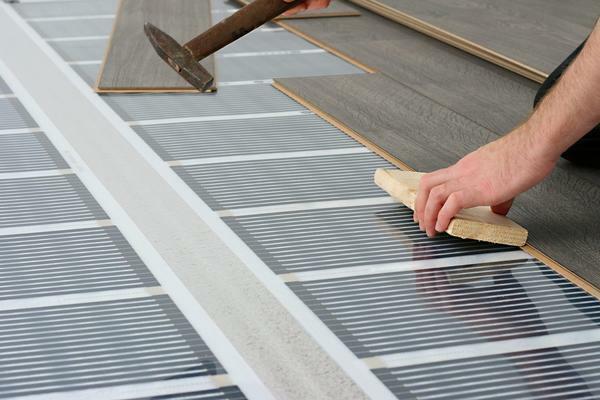 When laying a warm floor under a laminate, the type of room and the thickness of the floor covering must be taken into account.
When laying a warm floor under a laminate, the type of room and the thickness of the floor covering must be taken into account.
Each floor heating type for laminated fiberboard has its own installation, repair and operation features. It is necessary to carefully study the instruction and nuances of installation and operation before starting work.
Electrical warm floor for laminate: device and characteristics
For the construction of a warm electric floor for a laminated fiberboard, it is advisable to use ready-made thermal mats. In this case, the cable electrical floor should be made in a certain sequence.
Namely:
- The floor thermostat is mounted on the wall in the selected location at an altitude of about 30 cm.
- For the floor temperature sensor, a groove with a section of 20x20 mm is made. In this case, the parameters of the supply network and the wiring must correspond to the power of the warm floor.
- A smooth, non-cracked, clean concrete screed is prepared to create a warm floor. Further, places are marked where it is not necessary to lay a warm floor - under furniture, plumbing, etc.
- Heating mats are laid without overlapping and crossing the cable. Correction of the sizes of mats is carried out by cutting them into fragments without damaging the heating cable.
- Mounting wires of the heating mat are output to the terminal box of the thermostat.
- All wires and boxes must be located in grooves cut in the substrate, wall or screed.
- The installed floor heating is tested in accordance with the installation instructions.
The temperature sensor is placed in the special tube supplied. The end of the tube with the temperature sensor is tightly closed with a lid to avoid the ingress of building mortars and solutions. The sensor is placed in a hole prepared in the floor and is taken out to the box. The groove in the floor and wall, where the sensor is located with wires, is filled with cement mortar. The ends of the wires of thermal mats and the temperature sensor should be irradiated and connected to the terminals of the thermostat. Further, for 1 minute, the system is tested for performance according to the instructions.
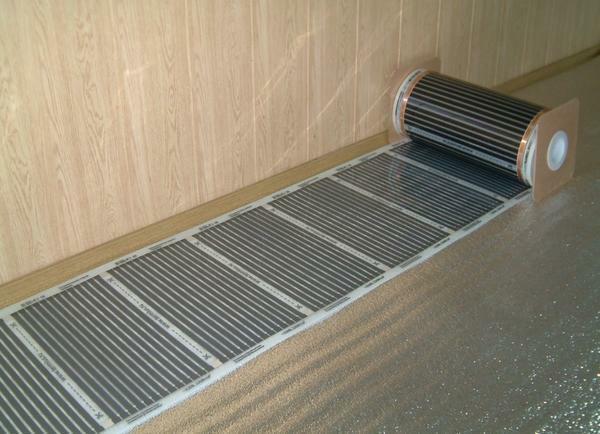 Among the advantages of an electric floor heating, the long life and efficiency of
Among the advantages of an electric floor heating, the long life and efficiency of
should be noted. After this, it is necessary to lay a substrate that is not afraid of heating. A laminate is placed on top of the mounted warm floor and the substrate.
The warm electric field, when covering about 70% of the room, provides heating of the room, as in case of independent heating, and has a high efficiency. In addition, for the cable floor it is better to use ready-made thermal mats that are easily mounted and dismantled in accordance with the instructions.
Laminate floor heating from water heating: Highlights
Quality outdoor water heating system starts from the project. The project contains such basic data as the design load on the heating system, the location of the distribution manifolds, the placement of heating circuits, the system for arranging the temperature sensors.
Correctly to lay a floor with water heating it is possible so:
- The surface for laying the floor is leveled and polished.
- The waterproofing material is laid on the prepared base( polyethylene film with a thickness of 100 microns).
- A damper strip is installed around the perimeter of the room with a warm floor. Further it is necessary to put a thermal insulation( for example, polystyrene).
- Then it is necessary to lay the reinforcing mesh and install heating circuits.
- A concrete screed( 5 to 10 cm thick) is poured on top of a pressurized water floor.
- Next, polyethylene film, substrate and laminate are laid.
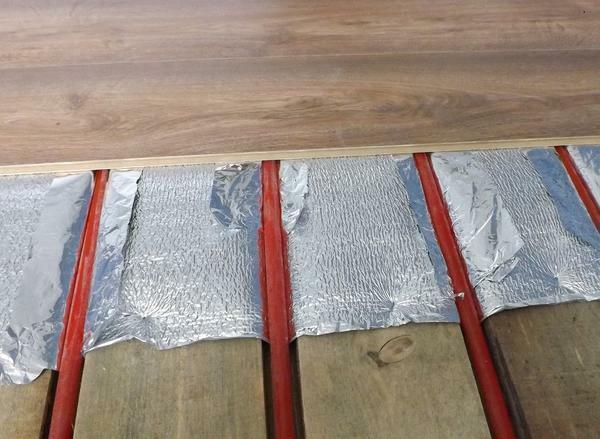 Before installing the hot water floor, it is worth to familiarize yourself with the advice of
Before installing the hot water floor, it is worth to familiarize yourself with the advice of
. The method and step for installing contours is specified by the project. Then the circuits are connected to the collector of the warm floor, balancing of the collector( according to the design table of balancing) and checking the system for leaks. A quality durable and efficient floor with water heating for laminated fiberboard can be designed and executed only by licensed companies that provide services for installation and adjustment of water-heated floors.
Infra-red floor for laminate:
features The tape( infrared) floor has such undeniable advantages as ease and ease of installation, dismantling, operation and repair, as well as high efficiency. The algorithm for laying the infrared film floor is simple.
Assembly:
- Determines the surface to be coated with the thermal film. It is important not to forget that under low-cost items and furniture, thermal film is not stacked.
- The place for the thermostat on the wall is selected.
- The whole floor surface is covered with heat-reflecting material( mats), which are fastened with a stapler or double-sided adhesive tape. The bands of the heat-reflecting material are also fixed with an adhesive tape.
- Lay the thermal film on the heat-reflecting layer with a copper strip down. Cut the thermal film into strips of the required size.
- We connect the insulation. To do this, isolate the bitumen insulation of the copper busbar cutting point.
- The floor thermo sensor is installed with bitumen insulation under the thermal film on the black strip of the heating element.
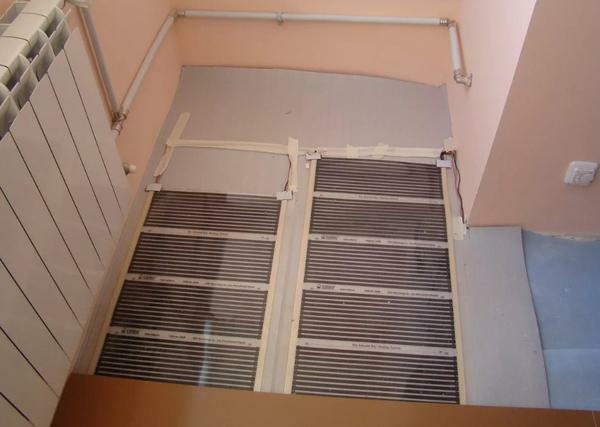 When buying an infra-red heated floor, ask the seller for a certificate confirming its quality.
When buying an infra-red heated floor, ask the seller for a certificate confirming its quality.
. Under the attached sensor, wires and terminals in the heat-reflecting mats, holes are made to maintain the evenness of the floor. The wires in the recesses are sealed with scotch tape. The wall of the thermoregulator is installed on the wall. The connecting wires are connected to the thermostat according to the instructions. If the system capacity is more than 2 kW, the thermostat is connected to the network by means of a separate automaton. After this, the system is tested for checking the absence of sparking, etc.(The maximum temperature is not more than 30 ° C).
The insulation must always cover the silver contacts that connect the carbon fiber heating strips to the copper busbar along the entire section. On the copper bus, in the places of future connection of wires, it is necessary to fix the contact clamps. It should be noted that the contact clamps must be positioned so that one side is on the outside, i.e. over the copper strip, and the second - inside the thermal film. Clamps of contacts tightly clamped pliers. Thermal film is fixed with adhesive tape between each other and on heat reflecting mats to exclude the possibility of shear. Then it is necessary to enclose the bare wires in the contact clamps and fix the pliers.
All points of supply of wires to the thermal film are insulated with two pieces of insulation from the kits.
In this case, the silver contacts must be completely insulated along the entire cutting line. After that, it is necessary to check the insulation of all connection points of the wires, the thermal film and all the lines of the tire cut. After testing, it is necessary to lay a protective polyethylene film or a special substrate under the laminate. Laminate is laid immediately on a plastic film or substrate. When installing the laminate, do not allow damage to the thermal film.
How to put a warm floor under a laminate( video)
Summing up, it can be noted that the most practical, easy to install, repair, operate and maximally safe version of a warm floor for a laminated fiberboard is the infrared electric film version.
